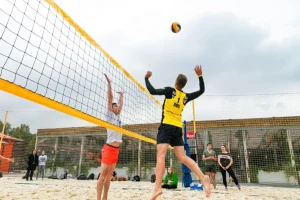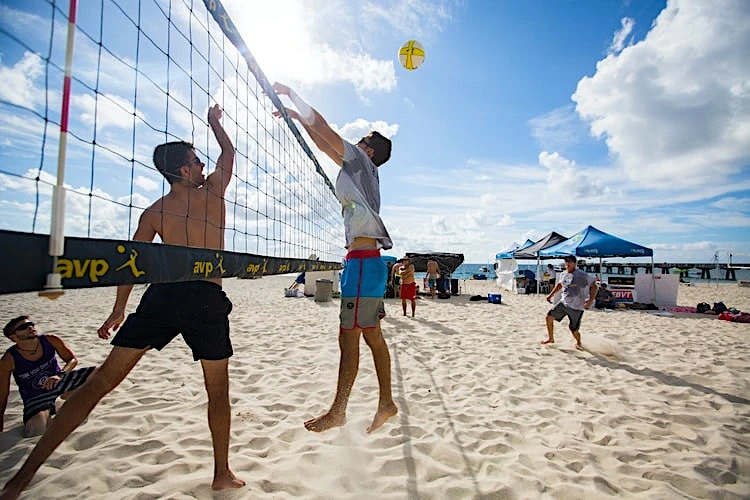Women’s volleyball injuries pose a significant concern, causing long-term health issues that can harm athletes’ careers and well-being. A health-focused guide to volleyball injury prevention helps women athletes proactively mitigate these risks. Volleyball injury prevention empowers athletes to control their health and develop targeted prevention methods.
By examining common volleyball injuries in women and exploring effective prevention techniques, a thorough guide becomes a valuable tool in enhancing athlete performance and promoting a culture of injury prevention.
Key Takeaways
- A health-focused guide empowers women athletes to take ownership of their health and well-being through education and prevention strategies.
- It reduces the incidence of injuries, resulting in improved performance and reduced long-term health consequences.
- The guide promotes a culture of injury prevention within volleyball teams, fostering community and shared responsibility.
- By understanding injury mechanisms and risk factors, athletes can develop targeted prevention strategies tailored to their needs.
- A health-focused guide optimizes athlete performance, enhances well-being, and helps women athletes achieve their full potential.
Common Volleyball Injuries in Women
Volleyball is a physically demanding sport that can lead to various injuries, particularly among female athletes. The fast-paced and high-flying nature of the game puts a tremendous amount of stress on the body, resulting in a range of common injuries.
One of the most prevalent injuries in women’s volleyball is the anterior cruciate ligament (ACL) tear. This injury often occurs when a player lands awkwardly from a jump or quickly changes direction on the court. Another common injury is patellar tendonitis, which is characterized by inflammation of the tendon connecting the kneecap to the shinbone. Shoulder injuries, such as dislocations and separations, are also common due to the overhead movements involved in spiking and blocking.
A Guide to volleyball injury prevention is essential in reducing the risk of these injuries. By understanding the common injuries that occur in women’s volleyball, athletes and coaches can take proactive steps to prevent them. This includes proper warm-up and cool-down exercises, strength training, and technique adjustments.
Benefits of Injury Prevention Guides
Effective injury prevention is multifaceted and requires an exhaustive approach. A guide to volleyball injury prevention can provide women athletes with a thorough resource to mitigate the risk of injury. One of the primary benefits of such a guide is that it empowers athletes to take ownership of their health and well-being. By educating themselves on injury prevention strategies, women volleyball players can better understand their bodies and make informed decisions about their training and competition.
A well-structured assist to volleyball injury prevention can also help athletes identify potential risk factors and develop targeted prevention strategies. This can lead to a reduction in the incidence of injuries, resulting in improved overall performance and a reduced risk of long-term health consequences. In addition, a health-focused guide can promote a culture of injury prevention within volleyball teams, fostering a sense of community and shared responsibility among athletes, coaches, and trainers. By prioritizing injury prevention, women volleyball players can optimize their performance, enhance their overall well-being, and achieve their full potential.
Understanding Injury Prevention Strategies
When it comes to mitigating the risk of injury in volleyball, understanding the underlying strategies that underpin a health-focused guide to volleyball injury prevention is essential. Effective injury prevention strategies in volleyball involve a combination of physical, technical, and tactical elements. A well-structured assist to volleyball injury prevention should address the prevention of acute and overuse injuries, which are prevalent among female volleyball athletes.
Acute injuries, such as ankle sprains and knee ligament tears, often result from sudden movements or falls. Overuse injuries, such as tendinitis and shin splints, occur due to repetitive stress and strain. Understanding the mechanisms of injury and the risk factors associated with each type is pivotal for developing effective prevention strategies. A thorough assist to volleyball injury prevention should also address the importance of proper warm-up and cool-down exercises, strengthening and conditioning programs, and the use of protective equipment. By understanding these strategies, women volleyball athletes can substantially reduce their risk of injury and maintain peak performance levels.

Integrating Health-Focused Training Methods
A well-structured guide to volleyball injury prevention should incorporate health-focused training methods that cater to the unique needs of female volleyball athletes. This approach acknowledges the distinct physiological and biomechanical characteristics of women, which can influence their susceptibility to injuries. By integrating health-focused training methods, female volleyball athletes can optimize their performance while minimizing the risk of injury.
An exhaustive assist to volleyball injury prevention should emphasize the importance of flexibility, strength, and neuromuscular control in preventing injuries. Female athletes can benefit from training methods that focus on improving their range of motion, muscular strength, and proprioception. This can be achieved through exercises that target specific muscle groups, such as the core, shoulders, and knees.
Effective Prevention Techniques for Athletes
Injury prevention strategies for female volleyball athletes can be substantially enhanced through the implementation of evidence-based prevention techniques. A well-structured guide to volleyball injury prevention is essential in providing athletes with the knowledge and skills necessary to minimize the risk of injury. Effective prevention techniques for athletes include incorporating exercises that target core strength, flexibility, and balance. Plyometric training, in particular, has been shown to reduce the risk of ACL injuries, which are common among female volleyball athletes.
Additionally, neuromuscular training programs can help improve joint stability and movement patterns, thereby reducing the risk of injury. These programs typically involve exercises that challenge the athlete’s proprioception and reaction time. By incorporating these prevention techniques into their training regimen, female volleyball athletes can markedly reduce their risk of injury and maintain peak performance levels. A thorough guide to volleyball injury prevention can provide athletes with the resources and support necessary to develop effective prevention strategies.
Frequently Asked Questions
What Are the Most Effective Warm-Up Exercises for Volleyball Players?
Effective warm-up exercises for volleyball players include dynamic movements such as leg swings, high knees, and arm circles, as well as plyometric drills like jump squats and box jumps to enhance power and agility.
Can Yoga Help Prevent Volleyball Injuries in Female Athletes?
Yoga can be a valuable supplement to traditional training methods, helping female volleyball athletes prevent injuries by enhancing flexibility, balance, and core strength, while also reducing muscle tension and improving overall athletic resilience and performance.
How Often Should Volleyball Players Stretch to Prevent Injury?
Volleyball players should incorporate stretching into their daily routine, ideally 3-5 times a week, focusing on major muscle groups such as hamstrings, quadriceps, and hip flexors, to enhance flexibility and prevent injury.
What Role Does Nutrition Play in Volleyball Injury Prevention for Women?
Proper nutrition plays a significant role in volleyball injury prevention, as a balanced diet rich in protein, complex carbohydrates, and healthy fats supports muscle function, joint health, and recovery, ultimately reducing the risk of injury.
Are There Specific Volleyball Injury Prevention Tips for Players Over 30?
For volleyball players over 30, targeted prevention strategies include modifying training intensity, incorporating low-impact warm-ups, and focusing on core strength and flexibility to mitigate age-related decline and reduce injury risk.
Conclusion
Optimized prevention strategies and health-focused training methods contribute to enhanced athlete performance, reduced injury incidence, and improved overall well-being. Effective implementation of injury prevention guides enables women volleyball athletes to minimize risk factors, develop targeted prevention methods, and promote a culture of injury prevention within their teams. By adopting a proactive approach to health and injury prevention, athletes can mitigate long-term health consequences and achieve their full potential in the sport.
You May Also Like To Read:
